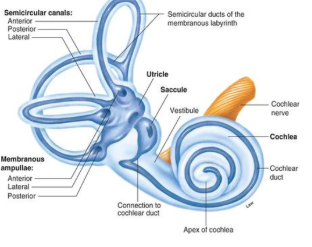PSYC102: Topic 4 - Sensation & Perception
1/81
There's no tags or description
Looks like no tags are added yet.
Name | Mastery | Learn | Test | Matching | Spaced |
|---|
No study sessions yet.
82 Terms
Sensation
The reception of stimulation from the environment.
The detection of physical energy by our sense organs which then relay info to the brain
Perception
Interpretation of the raw sensory information; often an automatic process
Pattern Recognition and Categorization
Link sensory info to existing knowledge
Sensation & Perception work through
Raw Data
Attention
Expectations & Previous Knowledge
Transduction
The process of converting an external stimulus into electrical activity within neurons
Sense Receptors
Special cells for converting external stimuli into neural activity
Sensory Adaptation
Activation is greatest when a stimulus is first detected, adapt after some time
Psychophysics
The study of how we perceive sensory stimuli based on their physical characteristics
Absolute threshold
The lowest level of a stimulus needed to be detected by the nervous system 50% of the time
Biological functions are not consistent from one time to the next
E.g., faint tone of the same intensity → only heard some of the time
Just Noticeable Difference (JND)
The smallest change in the intensity of a stimulus that we can detect
Weber’s Law
There is a constant proportional relationship between the JND and the original stimulus intensity
Light
Electromagnetic radiation
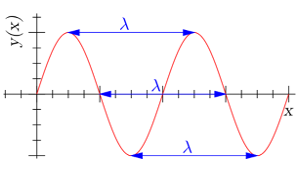
Wavelengths
We only perceive a narrow range of them,
different _____ = different colors
Peak to peak

Sclera
White of the eye
Iris
Coloured part of the eye that contains muscles that control the pupil, controlling how much light enters our eyes
Pupil
Circular hole through which light enters the eye
Pupillary Reflex: Closing as a reflex response to light or objects
Cornea
Curved, transparent layer covering the iris and pupil. Its shape bends light to focus the incoming visual image at the back of the eye.
Lens
Part of the eye that changes curvature to keep images in focus
Accommodation: changing shape of the ___ to focus on objects near or far
Flat=Distant
Fat=Near
Retina
Membrane at the back of the eye responsible for converting light into neural activity
Fovea: Central portion of the ____, responsible for sharpness of vision
Like a movie screen onto which light from the world is projected
Contains 2 types of receptor cells; rods and cones
Rods
Vision at low levels of light, very sensitive
Long, narrow, enable us to see basic shapes and forms
Dark adaptation: Time in dark before ____ regain maximum light sensitivity
110 million in each of your eyes
Cones
Vision at higher levels of light, sensitive to light and fine detail
Reading
Give us our colour vision
4.5-7 million in each eye
Photopigments
Chemicals that change following exposure to light.
Different types of receptor cells contain ____________
Optic nerve
Transmits visual information from the retina to the brain
The place where it connects to the retina is a blind spot
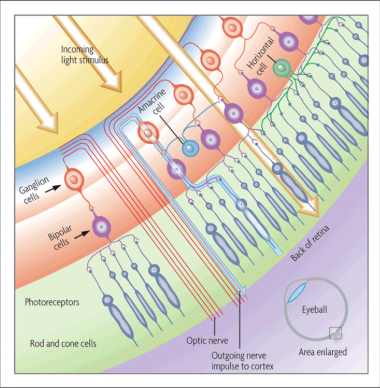
Ganglion cells
Cells in the retinal circuit that receive neural impulses and transmit information out of the eye
Axons from optic nerve
Photoreceptors
Different ones have different wavelengths, they have pigments that are sensitive to receiving the light energy
Left Visual Field
Hits the right half of each eye
Right Visual Field
Hits the left half of each eye
Trichromatic Theory
Colour vision on 3 primary colours, 3 types of cones with differing photosensitivity
Colourblindness: Inability to see some of all of the colours
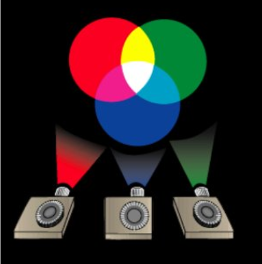
Opponent Process Theory
We perceive colour using opposite cells
Photoreceptors are linked together in pairs of opposite colours, activation of one prohibits perception of the other
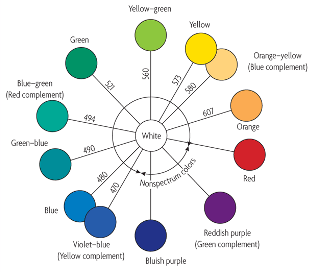
Center-surround cells
Fires when light is presented to a small circular area in a specific location of the retina
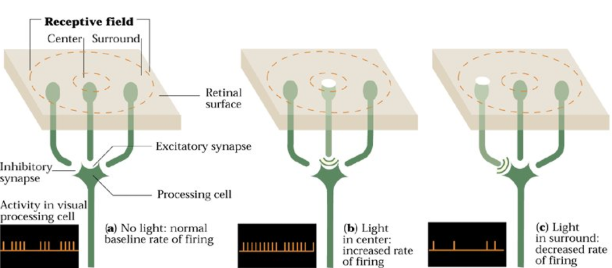
Feature Detection Cells
Detect lines and edges
Simple Cells: Detect lines and edges in very specific locations and orientations
Complex Cells: Detect lines and edges in less restricted locations (broader)
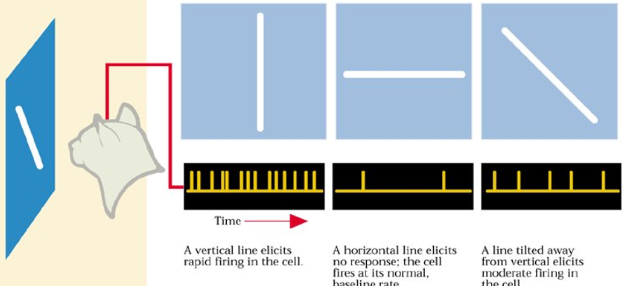
Bottom-up/Data-Driven Processing
Analysis and integration of basic features into a perceptual unit.
Hierarchical Organization
Form perceptual units through a process of increasingly complex connections between simple units
Parallel Processing
The ability to attend to many sense modalities simultaneously
E.g., perception of many different features of a lion (e.g., shape, orientation, colour)
Advantages:
Fast processing
Allows for top-down processing
Each type of processing can be influenced by the others
Top-Down Processing
When context and higher-level knowledge influence lower level processes
Use existing knowledge to allow us to understand the world more readily

Gestalt Principles
Give us insight into the ways we perceive form. -
Focused on the whole rather than the individual parts
Pattern and object recognition is a problem-solving process
Gestalt; Principle of Simplicity
When we have sensory input our perceptual system usually tries to create a percept that is: simple, orderly, and as stable as possible
Gestalt; Law of Proximity
Objects that are physically close to each other tend to be perceived as unified wholes or groups

Gestalt; Law of Similarity
Similar visual elements form a whole
Shape, colour, etc.
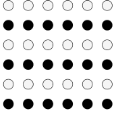
Gestalt; The Law of Closure
Objects are perceived as whole, even if they are not complete

Gestalt; Law of Good Continuation/Continuity
We tend to perceive objects as forming smooth continuous patterns

Gestalt; Law of Symmetry
Object that are formed around a center point form a group or whole

Gestalt; Law of Figure-Ground Segregation
Tendency to structure the visual field into two parts: a figure and a background
Bistable percepts: stimuli can be perceived in one of two different ways (but not at the same time)
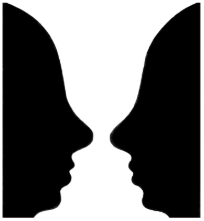
Motion
Brain judges it by rapidly comparing visual frames,
Visual info from one frame is compared to what is processed next
Phi Phenomenon
Perception of motion when stationary objects are flashed in quick succession
Depth Perception
Ability to see spatial relations in three-dimentsions and judge distance
Monocular Depth Cues (one eye)
Pictorial Cues
Relative size, texture, interposition, height, light, linear perspective
Depth Through Motion: Motion Parallax: Nearby objects will tend to move faster than objects in the distance
Binocular Depth Cues (both eyes)
Brain makes comparisons between eyes
Binocular disparity: each eye transmits slightly different information to the brain
Binocular convergence: eyes turn inward to differing degrees when we focus on near objects
Perceptual Constancy
We perceive the properties of objects to be constant even through the stimuli around us change when the viewing circumstances change
Applies to size, shape, colour
Unconscious Inference
We combine information from the stimulus with other cues from the environment to derive perception
Size Constancy
Our ability to perceive objects as the same size no matter how far away they are from us
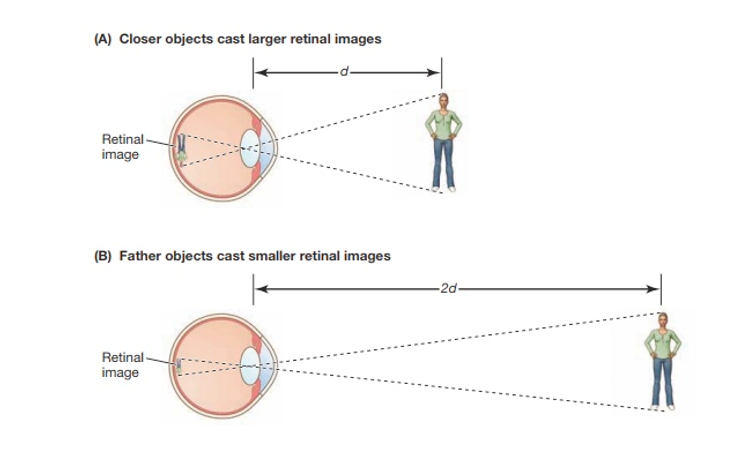
Shape Constancy
Our ability to perceive shapes as constant even as objects move or we move in relation to them
Give us a sense of coherence in the world

Colour Constancy
We perceive colours as (relatively) constant across lighting conditions, even though the actual image differs
Use cues based on context/background
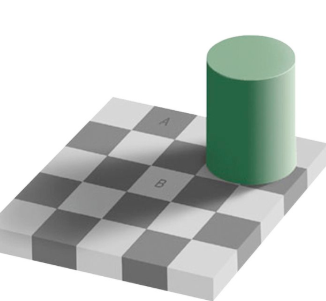
Agnosia
A failure or deficit in recognizing objects
Prosopagnosia
Deficit in recognizing faces
“The Man who Mistook His Wife for a Hat”
Apperceptive Agnosia
Deficit in recognizing patterns
Cant synthesize the parts of a stimulus into a whole

Associative Agnosia
Deficit in associating meaning and a pattern

Sound
Mechanical energy in the form of vibrations traveling through a medium (gas, liquid, solid) transmitted in waves
Frequency
The number of cycles a wave complete in a given time (corresponds to pitch)
Hz
Pitch Range: 20-20,000 Hz
Higher the cycles/second higher the frequency of the sound
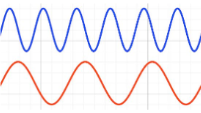
Amplitude
Height of the sound wave
dB
Loudness range: 0-160 dB

Outer ear; Pinna
Channels sound
Outer ear; Auditory Canal
Channels sound to eardrum
Outer ear; Eardrum
Thin membrane that vibrates according to the frequency of the sound
Middle Ear
Hammer, anvil, and stirrup: Vibrate at frequency of the sound; transfer the vibrations to the inner ear
Contains ossicle bones; transmit vibrations and magnify them
Inner ear; Oval Window
Receives amplified sound from ossicles, which cause vibrations in the fluid of the cochlea
Inner ear; Cochlea
Fluid filled inner cavity receives vibrations
Cochlea; Basilar Membrane
Reacts to the vibrations in the fluid
Not a uniform structure, narrow and stiff near the base
Cochlea; Organ of Corti
Contains hair cells that are stimulated by different vibrations and perform the process of transduction
Place Theory/Coding
Different frequencies stimulate different locations on Basilar Membrane
Narrow at base, wide at apex
Waves selectively vibrate the membrane
Higher pitch sounds do not travel as far as lower pitch sounds
5000-20000 Hz
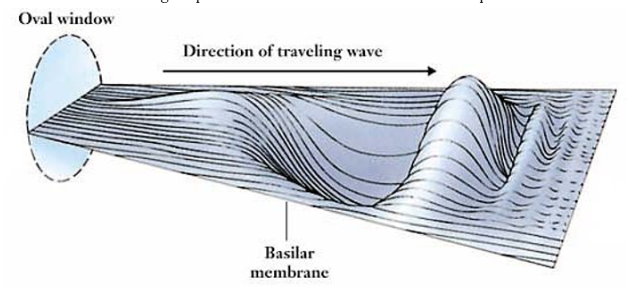
Frequency Theory/Principle
Tones with different frequencies cause neurons to fire at different rates
Explains low frequency range for pitch perceptions
Can only fire so many times per second
Like individual archers
100-500 Hz
Rates of neurons firing
Volley Theory
Sets of neurons fire just out of sync with each other to code for frequency above the rate at which neurons can fire
Groups of archers
500-5000 Hz
Both frequency and place
Interaural level (intensity) difference
Difference in sound intensity arriving at each ear
Acoustic shadow: reduction in sound for the far ear
Best for high freq. sounds
Interaural time difference
Sounds arrive at each ear at different times due to different spatial locations
More effective for low frequencies
Olfaction
Our sense of smell
Gustation
Our smell of taste
Odors
Airborne chemicals that interact with receptors in the lining of our nasal passages
Our nose detects between 2,000 and 4,000
Taste bud
Sense receptor in the tongue that responds to:
Sweet, Salty, Sour, Bitter, Umami
In bumps on the tongue called papillae
Olfactory Neurons
Contain a single type of olfactory receptor, which recognizes an odorant on the basis of its shape
Pheromones
Odorless chemical that serves as aa social signal to members of one’s species
Somatosensory
Sensory of touch, pressure, temperature, and injury
How we sense somatosensory stimuli
Free Nerve Endings
Can be polymodal
Are often nociceptors
Other specialized nerve endings
Slow and fast-adapting
Many types: can be very specialized
Withdrawal Reflex
Pull away prior to conscious decision
Proprioception
Our sense of body position
Proprioceptors sense muscle stretch and force
Vestibular sense
Our sense of equilibrium or balance
Semicircular canals in the inner ear are filled with fluid
Information is sent to parts of the brainstem that control eye muscles
